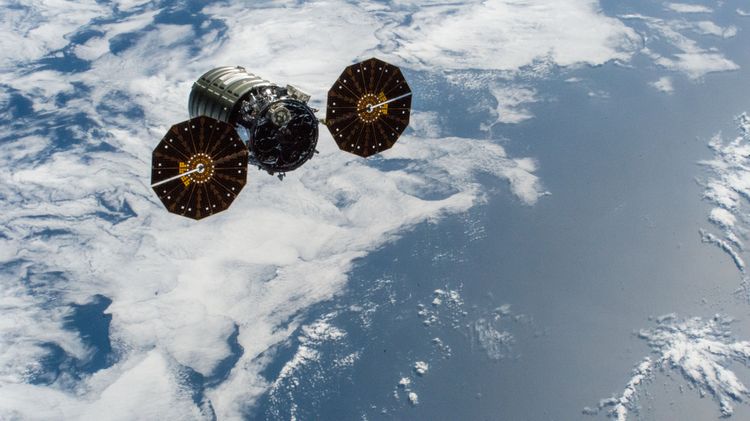
The Cygnus cargo spacecraft completed its latest resupply mission to the International Space Station (ISS) for NASA today (Feb. 25) with a death dive into Earth's atmosphere.
The robotic Cygnus vessel — named "S.S. John Young" after the late commander of NASA's Apollo 16 moon mission — launched in November atop an Antares rocket and delivered about 7,400 lbs. (3,350 kilograms) of supplies and scientific gear to the orbiting lab.
The freighter, which is built by aerospace company Northrop Grumman, stayed docked to the station for 81 days. It departed on Feb. 8, loaded up with more than 5,500 lbs. (2,500 kg) of trash for fiery disposal upon re-entry. [Private Antares Rocket & Cygnus Spacecraft Explained (Infographic)]
But that plunge didn't occur immediately, because Cygnus had more work to do as a free flyer on a bonus commercial mission. The freighter deployed multiple tiny cubesats into Earth orbit for various customers, and it also operated an onboard commercial payload for a while.
"It was a flawless mission for Cygnus that further demonstrated its ability to operate as an in-orbit science platform and launch pad for deployment of commercial cubesats on extended missions," Frank DeMauro, vice president and general manager of space systems at Northrop Grumman, said in a statement.
Cygnus burned up over the Pacific Ocean, east of New Zealand, at 4:05 a.m. EST (0905 GMT) this morning, Northrop Grumman representatives said.
The just-completed resupply mission was the 10th flown by the Cygnus/Antares duo under a CRS-1 (Commercial Resupply Services, phase 1) contract with NASA. The next flight, in April, will be the final one under this deal; deliveries under the next contract, known as CRS-2, will begin this fall.
Get the Space.com Newsletter
Breaking space news, the latest updates on rocket launches, skywatching events and more!
SpaceX also flies commercial resupply missions to the ISS for NASA, using its robotic Dragon cargo capsule and Falcon 9 rocket. Unlike Cygnus, Dragon is reusable; the latter craft makes parachute-aided ocean splashdowns, so it can bring scientific samples and other gear down to Earth for analysis.
SpaceX is also working on a crewed variant of Dragon under a separate commercial-crew contract with NASA. Crew Dragon is scheduled to launch on its maiden flight, an uncrewed trip to the ISS known as Demo-1, this Saturday (March 2). If all goes well with Demo-1, the capsule could carry its first astronauts to the orbiting lab in July.
Aerospace giant Boeing also holds a NASA commercial-crew contract. Boeing's CST-100 capsule will fly its first uncrewed mission to the station no earlier than April.
Mike Wall's book about the search for alien life, "Out There" (Grand Central Publishing, 2018; illustrated by Karl Tate) is out now. Follow him on Twitter @michaeldwall. Follow us on Twitter @Spacedotcom or Facebook.
Join our Space Forums to keep talking space on the latest missions, night sky and more! And if you have a news tip, correction or comment, let us know at: community@space.com.

Michael Wall is a Senior Space Writer with Space.com and joined the team in 2010. He primarily covers exoplanets, spaceflight and military space, but has been known to dabble in the space art beat. His book about the search for alien life, "Out There," was published on Nov. 13, 2018. Before becoming a science writer, Michael worked as a herpetologist and wildlife biologist. He has a Ph.D. in evolutionary biology from the University of Sydney, Australia, a bachelor's degree from the University of Arizona, and a graduate certificate in science writing from the University of California, Santa Cruz. To find out what his latest project is, you can follow Michael on Twitter.









